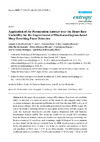Identificador persistente para citar o vincular este elemento:
https://accedacris.ulpgc.es/jspui/handle/10553/43075
| Título: | Application of the permutation entropy over the heart rate variability for the improvement of electrocardiogram-based sleep breathing pause detection | Autores/as: | Ravelo-García, Antonio G. Navarro-Mesa, Juan L. Casanova-Blancas, Ubay Martin-Gonzalez, Sofia Quintana-Morales, Pedro Guerra-Moreno, Iván Canino-Rodríguez, José M. Hernández-Pérez, Eduardo |
Clasificación UNESCO: | 3307 Tecnología electrónica | Palabras clave: | Apnea Recordings Algorithms Dynamics |
Fecha de publicación: | 2015 | Publicación seriada: | Entropy | Resumen: | In this paper the permutation entropy (PE) obtained from heart rate variability (HRV) is analyzed in a statistical model. In this model we also integrate other feature extraction techniques, the cepstrum coefficients derived from the same HRV and a set of band powers obtained from the electrocardiogram derived respiratory (EDR) signal. The aim of the model is detecting obstructive sleep apnea (OSA) events. For this purpose, we apply two statistical classification methods: Logistic Regression (LR) and Quadratic Discriminant Analysis (QDA). For testing the models we use seventy ECG recordings from the Physionet database which are divided into equal-size learning and testing sets. Both sets consist of 35 recordings, each containing a single ECG signal. In our experiments we have found that the features extracted from the EDR signal present a sensitivity of 65.6% and specificity of 87.7% (auc = 85) in the LR classifier, and sensitivity of 59.4% and specificity of 90.3% (auc = 83.9) in the QDA classifier. The HRV-based cepstrum coefficients present a sensitivity of 63.8% and specificity of 89.2% (auc = 86) in the LR classifier, and sensitivity of 67.2% and specificity of 86.8% (auc = 86.9) in the QDA. Subsequent tests show that the contribution of the permutation entropy increases the performance of the classifiers, implying that the complexity of RR interval time series play an important role in the breathing pauses detection. Particularly, when all features are jointly used, the quantification task reaches a sensitivity of 71.9% and specificity of 92.1% (auc = 90.3) for LR. Similarly, for QDA the sensitivity is 75.1% and the specificity is 90.5% (auc = 91.7). | URI: | https://accedacris.ulpgc.es/handle/10553/43075 | ISSN: | 1099-4300 | DOI: | 10.3390/e17030914 | Fuente: | Entropy,v. 17, p. 914-927 |
| Colección: | Artículos |
Citas SCOPUSTM
46
actualizado el 08-jun-2025
Citas de WEB OF SCIENCETM
Citations
40
actualizado el 12-ene-2026
Visitas 5
158
actualizado el 10-ene-2026
Descargas
140
actualizado el 10-ene-2026
Google ScholarTM
Verifica
Altmetric
Comparte
Exporta metadatos
Los elementos en ULPGC accedaCRIS están protegidos por derechos de autor con todos los derechos reservados, a menos que se indique lo contrario.
